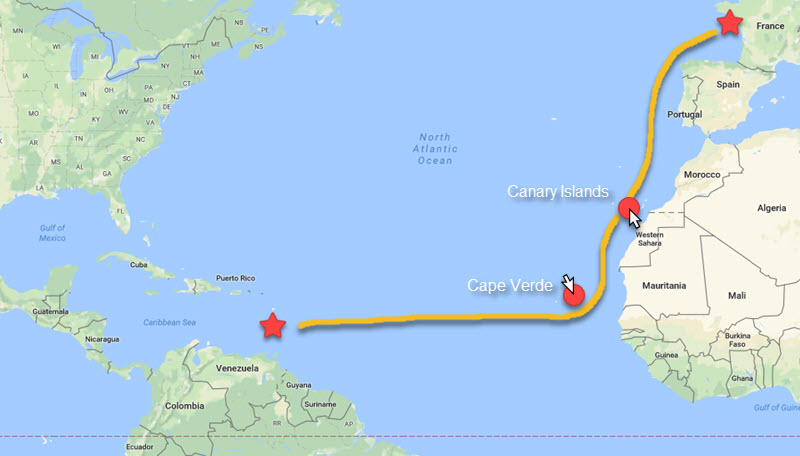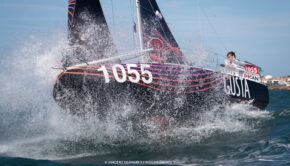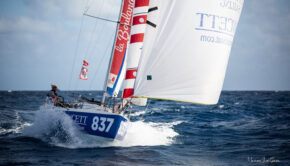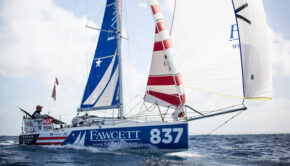Mini Transat: The wind shadow zone
Published on November 6th, 2017
(November 6, 2017; Day 5) – There are now six sailors in the Mini-Transat la Boulangère making a pit-stop to effect repairs at Mindelo amid the Cape Verde archipelago, a turning mark added to keep the fleet of singlehanders to the south of potentially dangerous storms.
It must be a long time since the channel between Santo Antao and Sao Vicente has seen so much traffic. For the past twenty-four hours, there has been a steady stream of Minis creating a bottleneck in this little stretch of water with over fifty boats having now set a course for the West Indies.
However, before they can sample the delights of the long surf of the Atlantic swell, they have one last obstacle to negotiate: getting past the wind shadow created by the mountains of Santo Antao. Whether it’s a question of character or a more long term strategy, two theories are clashing here.
Those keen to take a gamble are gallantly trying their luck by opting to cut in immediately to leeward of Santo Antao, there where the cone-shaped wind shadow is at its narrowest point. The upshot of this is a rather tough section where the skipper has to know how to hunt down the slightest puff of breeze, but where the route northwards is freed up quickly.
Some sailors have been revelling in this option, including Jörg Riechers (Lilienthal) on a prototype and Guillaume Combescure (Mini Oiri) on a production boat. The German sailor Lina Rixgens (Mini Doc) has also made this gamble. For others, this choice has enabled them to benefit from a few hours of light winds to carry out repairs at sea without having to indulge in the compulsory pit-stop option and its subsequent time penalty.
In this way, Yann Burkhalter (Kalaona) has been able to fix an issue with play on his rudder bearing, which had been forcing him to sail using the emergency tiller and hence hand steer for the bulk of the time. Similarly, David Allamelou (Boréal) has stopped in the open ocean to laminate his damaged bowsprit. In any case, traversing the zone affected by the wind shadow as perpendicularly as possible is the only solution possible to avoid being stuck fast for hours.
The other solution is to circumnavigate the wind shadow zone by bearing south the moment you exit the channel. Besides the fact that it’s a considerable detour, it comes as no surprise. In this way, Victor Barriquand (La Charente Maritime), Andrea Pendibene (Pegaso Marina Militare) and Luc Giros (Cabinet Rivault Nineuil – Enedis) have been ensnared by a zone of light airs around thirty miles to leeward of the dizzying heights of Santo Antao. Decidedly the road to the West Indies has to be earned this year.
At the head of the race, such problems are a distant memory for the leaders, who are now creaming along at an average speed of over 10 knots. There are no major shake-ups aside from the fact that in the production boats, Erwan Le Draoulec (Emile Henry) has snatched power just three miles ahead of Tanguy Bouroullec (Kerhis – Cerfrance). Behind them, a battle royal is shaping up for fourth place between Pierre Chedeville (Blue Orange Games – Fair Retail), Benoît Sineau (Cachaça 2) and Thomas Dolan (offshoresailing.fr). This trio is grouped within a six-mile radius and the daggers are drawn.
Of particular note is the performance posted by Nolwen Cazé (Fée Rêvée), who has gradually moved up to the front of the chasing pack of pointy-nosed boats, accompanied by Mathieu Lambert (Presta Service Bat) and Frédéric Moreau (Petit Auguste et Cie). At the finish of the first leg, the young woman didn’t have enough adjectives to describe how happy she was to be at sea and now she has discreetly propelled herself towards the front of the fleet. Enjoyment and performance are indisputably linked.
List of leg two casualties to date:
• Arthur Léopold-Léger (Antal XPO): rudder damage and partially delaminated transom.
• Rémi Aubrun (Alternative Sailing – Constructions du Belon): autopilot issues.
• Julien Héreu (Poema Insurance): broken bowsprit, masthead halyard to be re-moused, generator no longer starting.
• Andreas Deubel (www.andreasdeubel.de): mast wand issue.
• Pavel Roubal (Pogo Dancer): fuel cell no longer working and helm issue.
• Ambrogio Beccaria (Alla Grande Ambecco): broken bowsprit. The Italian sailor is turning back and heading for Mindelo.
• Thibault Michelin (Eva Luna): rudder damage.
• Elodie Pédron (Manu Poki et les Biotechs) has repaired her rudder and everything’s now working again so she won’t be making a pit-stop at Mindelo.
Position report on 6 November at 15:00 UTC
Prototypes
1 Ian Lipinski (Griffon.fr) 1,729.6 miles from the finish
2 Simon Koster (Eight Cube Sersa) 73 miles behind the leader
3 Jorg Riechers (Lilienthal) 85.7 miles behind the leader
4 Andrea Fornaro (Sideral) 128.5 miles behind the leader
5 Charlotte Méry (Optigestion – Femmes de Bretagne) 129.6 miles behind the leader
Production boats
1 Erwan Le Draoulec (Emile Henry) 1,886.2 miles from the finish
2 Tanguy Bouroullec (Kerhis – Cerfrance) 3 miles behind the leader
3 Clarisse Crémer (TBS) 11.6 miles behind the leader
4 Pierre Chedeville (Blue Orange Games – Faire Retails) 63.3 miles behind the leader
5 Benoît Sineau (Cachaça 2) 69.4 miles behind the leader
Class news – Race news – Tracking – Facebook
Race Facts
· 21st edition
· 4,050 miles to cover between La Rochelle – Las Palmas in Gran Canaria and Le Marin (Martinique)
· 81 skippers at the start
· 10 women
· 11 nationalities
· 20 years: age of the youngest skipper in the race: Erwan Le Draoulec
· 62 years: age of the oldest skipper in the race: Fred Guérin
· 25 prototypes
· 56 production boats
· 66 rookies
· 15 ‘repeat offenders’
Background
With an overall length of 6.50m and a sail area pushed to the extreme at times, the Mini Class offers incredibly seaworthy boats. Subjected to rather draconian righting tests and equipped with reserve buoyancy making them unsinkable, the boats are capable of posting amazing performances in downwind conditions… most often to the detriment of comfort, which is rudimentary to say the least.
The Mini Transat has two legs to carry the fleet from La Rochelle, France to Martinique, West Indies. The leg from La Rochelle to Las Palmas de Gran Canaria is a perfect introduction to proceedings before taking the big transatlantic leap.
The first leg starts on October 1, with the fleet thrust into the Bay of Biscay which can be tricky to negotiate in autumn, while the dreaded rounding of Cape Finisterre on the north-west tip of Spain marks a kind of prequel to the descent along the coast of Portugal. Statistically, this section involves downwind conditions, often coloured by strong winds and heavy seas. Making landfall in the Canaries requires finesse and highly developed strategic know-how.
The second leg begins on November 1, with the solo sailors most often carried along by the trade wind in what tends to be a little over two weeks at sea on average. Due to a storm, the fleet is being routed south to Cape Verde before heading west. At this point, there’s no way out: en route to the West Indies, there are no ports of call. The sailors have to rely entirely upon themselves to make Martinique.
Source: Aurélie BARGAT | Effets Mer










 We’ll keep your information safe.
We’ll keep your information safe.